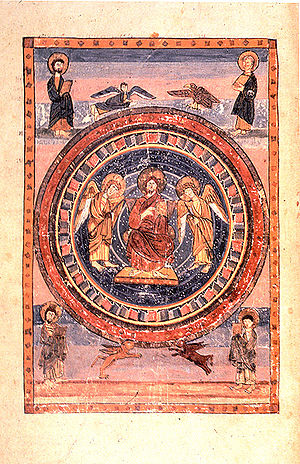Gospel

Codex Amiatinus
Gospel, derived from gōdspel (gōd "good" + spel "news"), the Old English translation of Ancient Greek εὐαγγέλιον eu-angélion, means "good news" or "glad tidings". This term usually refers to the four Gospels according to Matthew, Mark, Luke and John in the New Testament of the Bible, which describe the earthly life of Jesus Christ, culminating in the Mystery of Golgotha. In addition, other Gospels have been handed down that do not belong to the biblical canon and are counted among the Apocrypha of the New Testament.
The four evangelists have been represented in Christian iconography since the 4th century by four winged symbols: A man symbolises Matthew, the lion Mark, the bull Luke and the eagle John. These symbols, which until the 13th century were also combined into a single entity bearing the designation tetramorph taken from the Greek, are also found as attributes in figurative representations of the evangelists.
According to Rudolf Steiner, both the Synoptics and John the Evangelist were initiates, each coming from different schools of initiation. Only John was an eyewitness. The other Gospel writers (= Synoptics) took the material from the Akasha Chronicle.[1].
„Thus the Gospels are a renewal of the old descriptions of initiation, of the old initiation rules, and the writers of the Gospels said to themselves: Because that which otherwise only took place in the depths of the Mysteries once took place on the great plan of world history, therefore it may be described in the same words as the initiation rules are written. But that is why the Gospels are never meant as external biographies of the Christ-bearer. That is precisely the misunderstanding of modern Gospel research, that one wants to look for such an external biography of Jesus of Nazareth in it.“ (Lit.:GA 131, p. 31)
„When I myself approach the Gospels, no matter how often, I always have a very definite feeling, namely that in the Gospels, no matter how far one may have understood them, what one may have thought and said from them and about them - and one may, I emphasise this explicitly, approach them no matter how often - one always encounters something new. You never stop learning about the Gospels. But this learning about the Gospels is connected with something else; it is connected with the fact that the more one occupies oneself with them, the more admiration one feels for the depth of the content, precisely for, I would like to say, the immensity into which one is immersed and which actually evokes the feeling that there is no end to this possibility of immersion, that this admiration grows with every time one delves into the Gospels. However, one has some difficulties with regard to this path, which consist in the fact that when one has taken a few steps into the Gospels - I say "into" explicitly - one stumbles over the (textual) tradition. This is less of an obstacle for the actual spiritual scientist, because he is confronted with something like the Gospels with their, one might almost say, wordless text, and that makes it easier not to stumble over the tradition. Admiration, however, seems to me to be an indispensable element if the reading of the Gospels is to provide the basis for a religious teaching activity for the individual.“ (Lit.:GA 343, p. 190f)
Eternal Gospel
The Eternal Gospel (Latin: Evangelium æternum; Italian: Vangelo eterno) will be proclaimed, according to the Apocalypse of John, when the hour of judgement has come and the 144,000 saved have gathered who bear the sign of the Lamb and the Father on their foreheads. But those who worship the two-horned beast, whose number is 666, and bear its mark on their hand or on their forehead, will fall to the wrath of God (Rev 14:6–13).
Literature
- Rudolf Steiner: Das Johannes-Evangelium, GA 103 (1995), ISBN 3-7274-1030-2 English: rsarchive.org German: pdf pdf(2) html mobi epub archive.org
- Rudolf Steiner: Das Johannes-Evangelium im Verhältnis zu den drei anderen Evangelien, GA 112 (1984), ISBN 3-7274-1120-1 English: rsarchive.org German: pdf pdf(2) html mobi epub archive.org
- Rudolf Steiner: Das Lukas-Evangelium, GA 114 (2001), ISBN 3-7274-1140-6 English: rsarchive.org German: pdf pdf(2) html mobi epub archive.org
- Rudolf Steiner: Das Matthäus-Evangelium, GA 123 (1988), ISBN 3-7274-1230-5 English: rsarchive.org German: pdf pdf(2) html mobi epub archive.org
- Rudolf Steiner: Das Markus-Evangelium, GA 139 (1985), ISBN 3-7274-1390-5 English: rsarchive.org German: pdf pdf(2) html mobi epub archive.org
 |
References to the work of Rudolf Steiner follow Rudolf Steiner's Collected Works (CW or GA), Rudolf Steiner Verlag, Dornach/Switzerland, unless otherwise stated.
Email: verlag@steinerverlag.com URL: www.steinerverlag.com. Index to the Complete Works of Rudolf Steiner - Aelzina Books A complete list by Volume Number and a full list of known English translations you may also find at Rudolf Steiner's Collected Works Rudolf Steiner Archive - The largest online collection of Rudolf Steiner's books, lectures and articles in English. Rudolf Steiner Audio - Recorded and Read by Dale Brunsvold steinerbooks.org - Anthroposophic Press Inc. (USA) Rudolf Steiner Handbook - Christian Karl's proven standard work for orientation in Rudolf Steiner's Collected Works for free download as PDF. |
- ↑ Cf. Friedrich Göbel: Die Evangelisten. Eine biographische Betrachtung, Vlg. Edition Die Pforte, Dornach 1995
